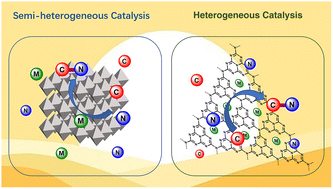Over the few decades, photochemistry has received great attention and become a powerful tool in organic synthesis. Heterogeneous photocatalysts present complementary advantages in production, separation, catalyst recycling, and stability compared to the traditional homogeneous photocatalysts. In this review, we choose C–N bond formation as a typical coupling reaction and summarize the development of a heterogeneous catalytic system and its advantages. Titanium dioxide, semiconductor quantum dots, covalent organic frameworks, and carbon nitrides are discussed in detail as important heterogeneous photocatalysts. The combination and electron transfer pathway between heterogeneous catalysts and transition-metal catalysts are the focus of this review. These advances are not only limited to the C–N coupling, but also extend to other coupling reactions.
